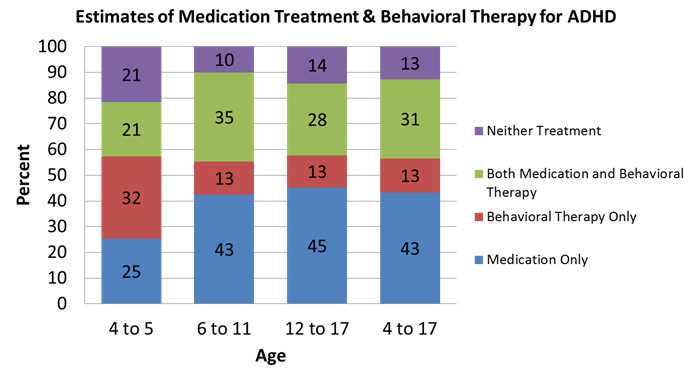Key Findings: Treatment of Attention-Deficit/Hyperactivity Disorder (ADHD) among Children with Special Health Care Needs

The Journal of Pediatrics has published a study, Treatment of Attention-Deficit/Hyperactivity Disorder among Children with Special Health Care Needs, describing parent-reported treatment of ADHD among children with special health care needs, and how this reported treatment aligns with the current American Academy of Pediatrics (AAP) guidelines. This was the first nationally-representative US study on ADHD treatment that considers medication, behavioral therapy, and dietary supplements. These data on ADHD treatment were collected just before the release of the current AAP medical practice guidelines, so this information can be used as a benchmark for how the state of medical practice at the time that the guidelines were published.
CDC researchers looked at data from a national sample of children with special health care needs, ages 4-17 years, collected in 2009-10. They found that just before the release of the 2011 guidelines, most children with ADHD received either medication treatment or behavioral therapy; however, many were not receiving treatment as outlined in the 2011 best practice guidelines. Current AAP guidelines recommend that for school-aged children (6-18 years of age) with ADHD, treatment include ADHD medication with or without behavioral therapy, with both medication and behavioral therapy as the preferred treatment. Behavioral therapy is recommended first for preschoolers (4-5 years of age) with ADHD.1
This is important information for healthcare providers so that they can gain a greater understanding of the patterns of treatment for ADHD, and what more may need to be done to improve the quality of care for children with ADHD.
Main Findings
Frequency of ADHD treatments across all ages
- 9 out of 10 children with ADHD were treated with medication and/or behavioral therapy, both of which are recommended ADHD treatments. Of these children:
- about 4 in 10 (43%) were treated with medication alone — the most common single ADHD treatment,
- about 1 in 10 (13%) received behavioral therapy alone, and
- about 3 in 10 (31%) were treated with combination therapy (medication and behavioral therapy).
- About 1 in 10 children with ADHD were receiving neither medication treatment nor behavioral therapy.
- About 1 in 10 were taking dietary supplements for ADHD, which are not currently recommended for the treatment of ADHD.

Did you know?
The behavior therapy with best evidence with young children with ADHD is Parent Training in Behavior Therapy.
From the American Academy of Pediatrics (AAP)

How treatment patterns in 2009-10 compare with current (2011) American Academy of Pediatrics’ recommendations
- Less than 1 in 3 children with ADHD received both medication treatment and behavioral therapy, the preferred treatment approach for children ages 6 and older.
- Only half of preschoolers (4-5 years of age) with ADHD received behavioral therapy, which is now the recommended first-line treatment for this group.
- About half of preschoolers with ADHD were taking medication for ADHD, and about 1 in 4 were treated only with medication.
State estimates of ADHD treatment among 4-17 year olds
- Medication treatment among children with ADHD ranged from a low of 57% in California to a high of 88% in Michigan.
- Behavioral therapy among children with ADHD ranged from a low of 33% in Tennessee to 61% in Hawaii.
- Access State by state data.
Conclusions and implications of this study
- At the time the current guidelines were released, treatment patterns were different from recommendations.
- Increasing rates of behavioral therapy among preschool-aged children with ADHD would increase the alignment of current practice and existing medical guidelines (best practice) for ADHD, and could improve the quality of care for children with ADHD.
- More recent data are needed to understand if the treatment patterns have become more aligned with the current medical practice guidelines. Future research and policy evaluation can help determine the factors and strategies that impact state rates of behavioral therapy among children with ADHD.
- Parents should be aware that there are recommendations for pediatric ADHD treatment and should seek care from an experienced provider.
- Healthcare providers should be aware of psychological resources in their community so that they are prepared to refer children, particularly preschoolers, for behavioral therapy as recommended by the American Academy of Pediatrics.
About this Study
CDC researchers used data from the 2009-10 National Survey of Children with Special Health Care Needs to describe how ADHD is treated across the United States. Most children with ADHD (about 9 in 10) are considered children with special health care needs because they use more healthcare resources than other children. Researchers determined the percentage of children with special health care needs aged 4-17 years with ADHD utilizing medication treatment, behavioral therapy, and dietary supplements.
CDC’s Work on ADHD
CDC monitors the number of children who have been diagnosed with ADHD through the use of national survey data. Questions about ADHD on national or regional surveys are used to learn more about the number of children with ADHD, their use of ADHD treatments, and the impact of ADHD on children and their families.
CDC also conducts community-based studies to better understand the impact of ADHD and other mental and behavioral health conditions on children and families living with these conditions. The Project to Learn about Youth (PLAY) study methods have been implemented in four community sites, and subsequently expanded to help us better understand ADHD and other mental and behavioral disorders, as well as the needs of children and families affected by these conditions.
CDC supports the National Resource Center on ADHD, a program of Children and Adults with Attention-Deficit/Hyperactivity Disorder (CHADD), which is a Public Health Practice and Resource Center. Their web site (http://www.help4adhd.org/NRC.aspx) has information based on the best medical evidence about the care for people with ADHD and their families. The National Resource Center operates a call center with trained, bilingual staff to answer questions about ADHD. Their phone number is 1-800-233-4050.
More Information
To learn more about ADHD and CDC’s work in the area of ADHD, please visit www.cdc.gov/adhd
Key Findings Reference
Visser, S. N., Bitsko, R. H., Danielson, M. L., Gandhour, R., Blumberg, S. J., Schieve, L., Holbrook, J., Wolraich, M., Cuffe, S. (2015). Treatment of attention-deficit/hyperactivity disorder among children with special health care needs. Journal of Pediatrics. Published online April 1, 2015, DOI: http://dx.doi.org/10.1016/j.jpeds.2015.02.018
Additional References
- American Academy of Pediatrics’ Subcommittee on Attention-Deficit/Hyperactivity Disorder Steering Committee on Quality Improvement and Management. (2011). “ADHD: Clinical practice guideline for the diagnosis, evaluation, and treatment of attention-deficit/hyperactivity disorder in children and adolescents.” Pediatrics. 128(5): 1007-1022.
- Page last reviewed: September 8, 2017
- Page last updated: September 8, 2017
- Content source:


 ShareCompartir
ShareCompartir